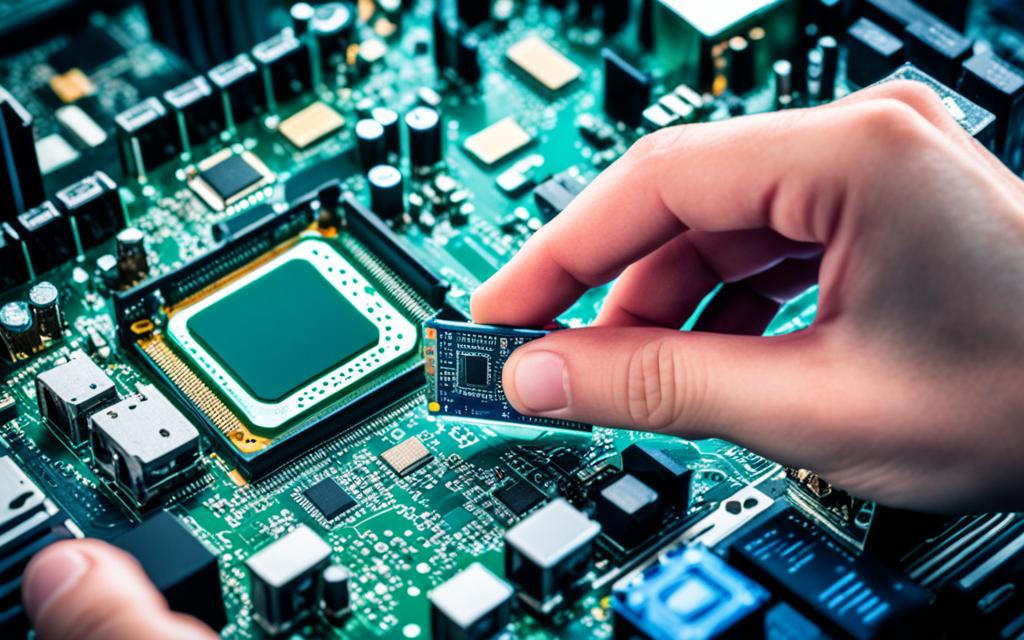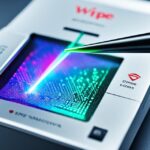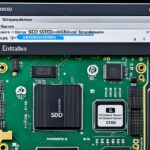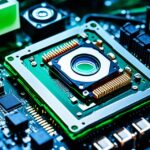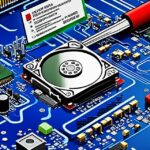Table of Contents
Wiping a hard drive is essential for data privacy, especially if you plan to sell or get rid of an old computer. It means permanently deleting all data to protect sensitive information. It’s crucial to back up important files like documents and photos first. This prevents accidental data loss. Formatting a hard drive can also fix problems caused by malware or hardware issues that seem related to software. Learning to wipe hard drive from BIOS boosts your data security. It prevents risks from not erasing data properly.
For more information, read about secure data erasure techniques. These can help you understand more about data risks. Or check out how to wipe a PC for more detailed methods.
Key Takeaways
- Understand the importance of securely erasing your hard drive before selling or disposing of it.
- Back up essential data to prevent loss during the wiping process.
- Utilise BIOS settings for a thorough wipe of your hard drive.
- Consider using professional tools like BitRaser Drive Eraser for compliance with data protection regulations1
- Familiarise yourself with various methods for wiping a hard drive, including Secure Erase and DiskPart commands2
Understanding the Need to Wipe a Hard Drive
Wiping a hard drive is very important in today’s digital world. It helps keep data private and reduces the risk of security problems. When people sell or give away their gadgets, they should wipe the hard drive. This makes sure personal and financial info stays safe and avoids identity theft.
Reasons for Wiping a Hard Drive
Some people might not think wiping their hard drive is necessary. But, there are strong reasons to do it:
- Compliance with data protection laws: Following the law requires carefully handling sensitive info, which means doing secure wipes.
- Preventing data recovery: If not wiped, sensitive data can still be retrieved, leading to unauthorised use and data leaks.
- Preparation for hardware changes: Wiping makes sure you can start fresh when getting new hardware or installing new software.
- Exercising good data hygiene: Regularly cleaning your drive keeps your security tight and prevents breaches.
Risks of Not Wiping Your Hard Drive
Not wiping your hard drive brings several risks. Leftover sensitive info can lead to identity theft. Also, ignoring hardware issues might cause more data loss. This shows wiping is crucial for protecting your online presence, not just for space.
What is BIOS and Its Role in Hard Drive Management
The Basic Input/Output System, or BIOS, is the core interface between computer hardware and the operating system. It ensures hardware components work correctly at boot-up. Hard drive management is a key BIOS function, important for system setups.
The Purpose of BIOS in Computers
BIOS is crucial when starting a computer. It runs the POST (Power-On Self Test) to check if key hardware, like the hard drive, is working. This step is essential before the operating system loads. It shows BIOS’s importance in basic computer operations, though it doesn’t manage tasks like data formatting.
Limitations of BIOS in Formatting Drives
BIOS has limits in formatting drives. Formatting needs an operating system interface, which BIOS lacks. While it starts hardware, formatting and wiping data need more specific methods. Tools like installation media or software are usually required. Understanding this helps explain why extra steps are needed for thorough hard drive management and data erasure34.
How to Wipe a Hard Drive from BIOS
Erasing a hard drive through BIOS needs careful steps for secure data removal. This means making bootable media. It also involves saving critical data elsewhere to avoid losing key info.
Preparing Your System for a Wipe
Start by preparing your system properly. Make sure to back up important files because wiping removes all data. Checking your backups prevents accidental data loss. Clearing your device is key, especially if you plan to sell or give it away.
Accessing BIOS Settings
To get into BIOS, reboot your computer. Quickly press the key needed, often F2, DEL, or ESC, as your computer starts. This step is vital for setting the boot order to your installation media. It makes the wiping process possible.
After entering BIOS, find the boot menu. Here, set your device to start from the media or tools you’ve set up. This ensures the wiping goes as planned, using different methods provided by the tools on your bootable drive.
There are several methods to choose from, like using EaseUS Bootable USB Format Tool or command line commands. These make formatting through BIOS easier5. Also, some tools give a deeper clean, offering more security and blocking data recovery attempts6.Find out more about how to thoroughly wipe a hard drive.
Methods to Wipe Your Hard Drive
Looking at how to wipe a hard drive, you have options like using setup media or DiskPart. Each method suits different levels of tech know-how and needs.
Using Installation Media
Starting with a USB or CD with Windows on it is simple. Boot from it, and the setup wizard takes over. You can then choose to format the drive. It’s great for fixing a computer that won’t start, making the hard drive like new7.
Employing DiskPart Command
DiskPart is for those who like more control. You use command-line instructions after starting your computer in Windows Recovery. It lets you manage and format drives in detail, offering a customized formatting option7.
Third-Party Tools for Secure Data Erasure
Using third-party tools for secure data deletion boosts your security. Tools like GParted, EaseUS, and AOMEI Backupper are reliable and full of features. They help erase hard drives safely, protecting sensitive info.
Before using any erasing software, make sure to back up important data. Once data is erased, it can’t be recovered.
Recommendations for Reliable Software
AOMEI Backupper is known for its all-around services. It lets users make bootable media for managing drives well. You can choose to wipe certain partitions or the whole drive, keeping your data safe.
Secure-erase utilities let you choose how many times to overwrite data. Three times is usually enough, meeting U.S. Department of Defense standards8. Eraser and Roadkil’s Disk Wipe are also good choices for data destruction.
Using AOMEI Backupper for Wiping
AOMEI Backupper is perfect for easy yet effective hard drive wiping. Its user-friendly interface makes creating bootable media and starting the wipe easy. It even works well with SSDs, considering their special needs.
Choosing secure data erase software follows data protection laws and is good for the planet. It ensures safe disposal of hardware9.
FAQ
Why is it important to wipe a hard drive before selling my computer?
Wiping your hard drive is key to keeping your private info safe. It makes sure your personal data doesn’t get into the wrong hands. Plus, it follows the law and stops identity theft by completely removing your personal details.
What risks are associated with not wiping my hard drive?
If you don’t wipe your hard drive, it’s like leaving your door unlocked. Strangers might get access to your private info, like bank details or personal messages. This can lead to identity theft or fraud.
How does BIOS play a role in wiping a hard drive?
BIOS checks your PC’s hardware when it starts but isn’t much help in wiping the hard drive. Wiping data usually needs you to be in the operating system.
What preparations should I make before wiping a hard drive?
Make sure to save your important files elsewhere first. Losing them can be a nightmare. Also, prepare a USB or disk to boot from. This will make the wiping process smoother.
What methods can be used to wipe a hard drive?
Two main ways to wipe a hard drive are using installation media or the DiskPart command. Either way, you can decide the best method based on your needs. Each one has its own benefits.
Which third-party tools are recommended for secure data erasure?
For a safe wipe, use trusted tools like GParted, EaseUS, or AOMEI Backupper. They’re built to make sure your hard drive is thoroughly cleaned. They play a crucial role in making data unrecoverable.
How does AOMEI Backupper assist in wiping a hard drive?
AOMEI Backupper lets you create a bootable drive to erase data securely. It offers options to wipe either some parts or the whole drive. Plus, it guarantees that once deleted, your data stays gone.
Source Links
- https://www.bitraser.com/blog/how-to-wipe-ssd-from-bios/ – Learn How to Wipe SSD From BIOS
- https://www.dell.com/support/kbdoc/en-us/000146892/dell-data-wipe – Dell Data Wipe | Dell US
- https://www.ubackup.com/articles/wipe-hard-drive-from-bios.html – Securely Wipe Hard Drive from BIOS and Reinstall Windows
- https://www.easeus.com/partition-master/wipe-hard-drive-from-bios.html – How to Wipe Hard Drive From BIOS – 4 Safe Ways 💡
- https://www.easeus.com/partition-master/format-hard-drive-from-bios.html – How to Format Hard Drive from BIOS in Windows [2024 How-to Tutorial]
- https://recoverit.wondershare.com/format-harddrive/wipe-hard-drive-from-bios.html – Secure Ways to Wipe or Erase a Hard Drive from BIOS
- https://www.stellarinfo.com/article/format-hard-drive-from-bios.php – Methods to Format a Hard Drive from BIOS
- https://www.pcworld.com/article/461014/how-to-securely-erase-your-hard-drive.html – How to securely erase your hard drive or SSD
- https://www.itamg.com/data-storage/hard-drive/wiping/ – How to wipe a hard drive: Windows 11,10, Mac OS, Linux

